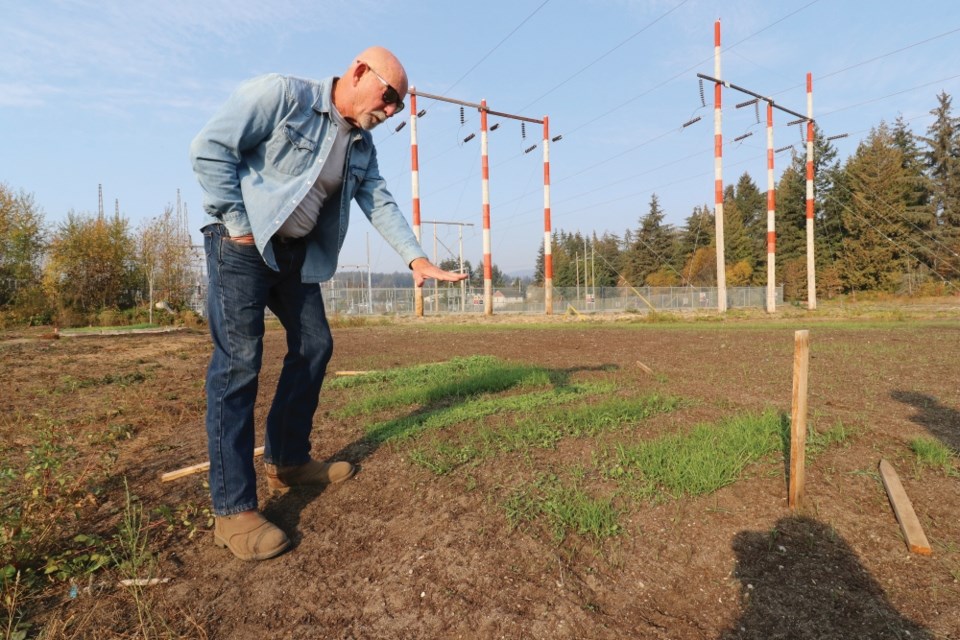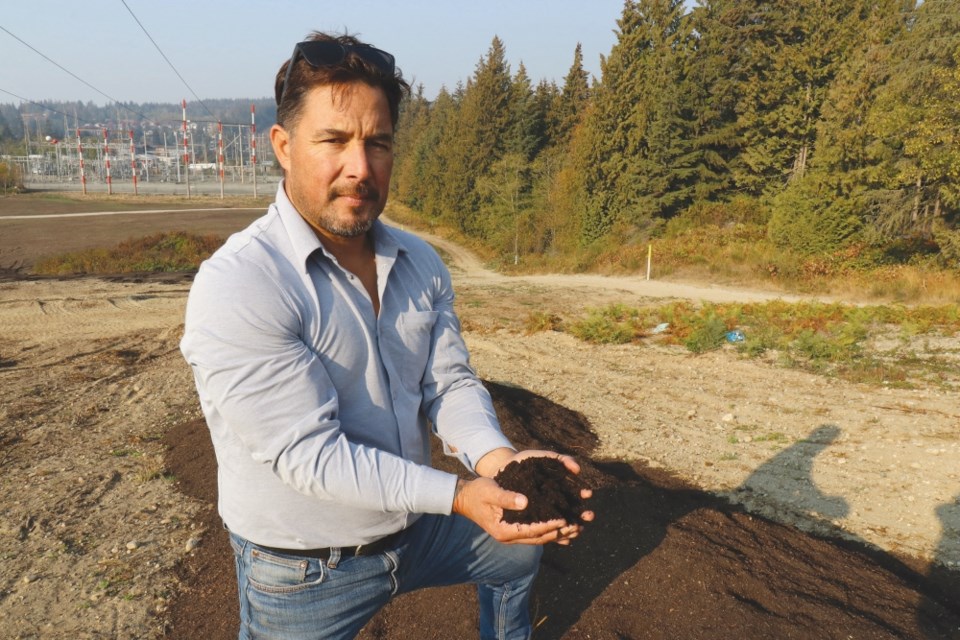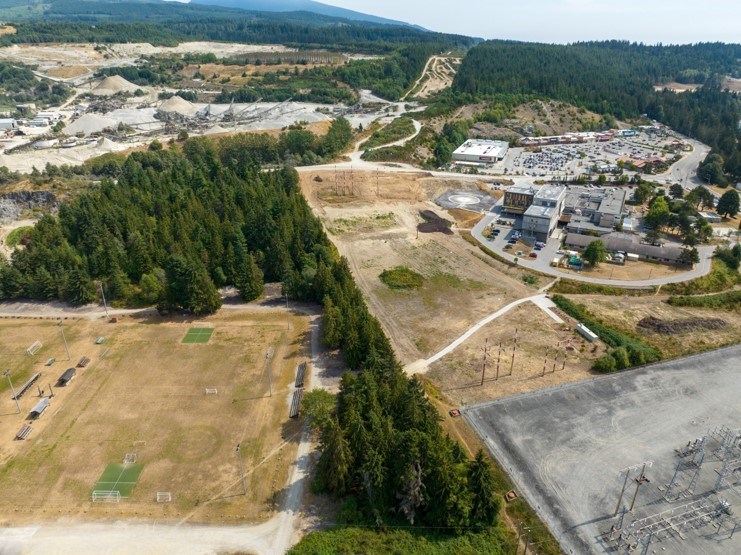The six or so acres of land behind Sechelt Hospital is not much to look at. For many years, the soil was bare except for invasive plants, sloping down from Ti’ta Way to the BC Hydro substation. But a new group sees the promise it holds: how barren land could be home to a healthy farm. It’s not much to look at — yet.
Over the past six months or so, the recently-formed Salish Seas Regenerative Farm Society acquired permission from the surrounding authorities — shíshálh Nation, BC Hydro and FortisBC — and they now have a three-year lease agreement with shíshálh Nation.
It was Aaron Joe, the CEO of Salish Soils, who selected the site. Driving past it daily, Joe saw how the land gets full sun and good exposure throughout the day. A walking path crosses it, connecting the East Porpoise Bay area and the Ted Dixon soccer field to downtown Sechelt and the Salish Sea — many people would pass by the site, and patients would be able to see it from their hospital rooms. Residents of Totem Lodge, the neighbouring long-term residential care facility, could use the garden paths.
The Salish Seas Regenerative Farm Society includes Sunshine Coast residents with experience in agriculture, compost, engineering, finances, healthcare and project management. A few years ago, five of their members participated in Al Gore’s seven-day Climate Reality program (online because of the pandemic). Out of that came a commitment to participate in a solutions-based community initiative.
What is a demonstration farm?
The farm is to serve as a highly visible example of how agriculture can rejuvenate land, and become a new source of food.
Most of the food eaten on the Sunshine Coast comes from somewhere else. A 2019 agricultural land use survey found only eight per cent of the 580 privately-owned Agricultural Land Reserve (ALR) parcels on the Sunshine Coast are farmed, and 29 per cent of land with crops lies outside the ALR. A food security action initiative report from 2006 revealed “in an emergency, the community only has enough food on hand for two or three days.”
John Talbot is a founding member and the chair of the society. He has a background in community development and last year, as Talbot was working to help plan redevelopment for the fire-ravaged community of Lytton, he asked himself how he is contributing to climate change.
“We all know that our environment is changing. And it’s changing at a speed that has surprised all of us,” he said. He began to look at how to make an impact locally.
In light of climate change and increasing challenges such as going from no rain to too much rain too quickly, the society is looking for ways to show the community how the Coast can be more self-sufficient and reduce greenhouse gas emissions by growing local food.
“The research project is demonstrating how to reclaim damaged landscapes and … show the outcomes,” Dave Ryan, the farm coordinator says. They know what is in the compost from Salish Soils, which type of compost is used where, and will analyse the outcomes with the help of Kwantlen Polytechnic University. Local farmers can then use the information to see what did and did not work.
Included in their visions are the pollinators. A small beehive is already onsite, and a space for greenhouses is ready — it just needs a greenhouse. Talbot hopes that people will consider donating underused equipment to the project. The concept also includes an outdoor classroom, raised beds for accessible gardening, and rainwater harvesting and storage. The trail would remain open, connecting the community.
“We want to have something positive, rather than doom and gloom, that people can see and participate in,” Talbot said.
Regenerative agriculture: Reduce and Produce
The property at the centre of this story was logged in the 1950s to become a BC Hydro right-of-way, Ryan says. Now, BC Hydro lines run above it, and FortisBC’s line runs below, stretching under the ocean to Vancouver Island. A helipad for the hospital, and the Sechelt Hospital itself, is close by.
BC Hydro has thousands of kilometres of transmission lines across the province. Where the company doesn’t own the land beneath the lines, it has right of way agreements with the property owners (government, First Nations or private owners). Under those agreements, BC Hydro can regulate anything that may jeopardize the integrity of the line or public safety.
Ted Olynyk, BC Hydro’s manager of community relations for Vancouver Island and the Sunshine Coast, told Coast Reporter there are a few community gardens proposed within transmission right of ways, and plenty of farming. In Saanich on Vancouver Island, a pollinator meadow was put under a transmission line.
“No proposal is the same,” he says. While BC Hydro isn’t offering financial support to the demonstration farm project under its lines in Sechelt, Olynyk said, “It's great when the land underneath the transmission line can be used for other purposes. Whether it be a tree farm or farming, whether it's a community garden like this, whether it's a pollinator meadow, it's great to see the land used appropriately.”

At the farm, Ryan said, “The foundation of this regenerative agriculture project is two things: compost and cover cropping to build soil life and health.” The other goal is to combat climate change by taking carbon dioxide out of the atmosphere and capturing it in the soil. Essentially, reduce carbon emissions and produce healthy food to increase food security, all in the same space.
Earlier this year, the property was cleared of invasive broom so the society could see what they’re working with. They then took soil samples to discover the level of toxicity. In mid-October, Ryan began a remediation prescription he developed with four other agricultural experts, including someone from the Ministry of Agriculture. Then came in the 350 yards of screened compost from Salish Soils, and two cover crops: hairy vetch and annual ryegrass. It will create a plant biomass, pulling in the nitrogen from the atmosphere, then building up the microbial life below the surface — creating soil stability, water retention and a nitrogen fixation.
A test patch shows there was successful germination, before it goes dormant (after Nov. 15 or so). The acres would look like a green carpet, Ryan says, had there been rain earlier. Instead, they trucked in water to use for the sample. Now that the rain has begun after an absence of more than 100 days, they’ll observe where the water goes on the property and will create a small pond toward the bottom of the slope that will catch the rain.
In February, more soil tests will show whether the remediation prescription worked to rebalance the soil. The cover crops will then be terminated in March, and laid on top of the soil to act as armour, protecting it. New crops will be planted on top, building on that layer.
Ryan thinks about 50 per cent of the area will be growing and they’ll be able to plant some food crops next spring.
“We use the word regenerative agriculture… because what we want to do is take this barren land and turn it into healthy soil, so that we can create a farm,” Talbot says.
New kids on the block
As with all farms, the Salish Seas Regenerative Farm Society has to keep the sustainability of the operations in mind. Farming in general has little, if any, profit. One of the biggest challenges facing the project is finding the resources: materials, equipment and funding.
The project is not lacking in volunteer power. Talbot says they’ve been able to find people with the technical skills. The society has also begun to work with some of the other farms on the Coast.
So far, funding has come from a grant from the Ministry of Agriculture and federal government to host two public workshops. Another $11,000 came from the Sunshine Coast Community Forest (SCCF) Legacy Fund to purchase equipment. The society is working on a fundraising strategy, from individuals, businesses and organizations, and the more typical approach of seeking government grants, but first needs to lay the groundwork of the project (literally).
“This year, it's the foundation because, as you know, we're the new kids on the block,” Talbot said. “We want to come at it with humility, and we want to be able to build partnerships,” including with the hospital and shíshálh Nation.
Growing to heal
The Sechelt demonstration farm would not be the first farm to partner with a hospital. A 2013 Cornell University survey found that 58 per cent of 101 hospitals in the northeastern U.S. had a “farm to hospital” program, and another 11 per cent were interested in adopting one.
The group is in discussions with the Sechelt Hospital’s food services to learn what kinds of produce they would be able to accept. So far, they’ve been supportive of the idea, Talbot said.
“I mean, having great local foods produced here that are used in the hospital? It would be lovely,” Talbot said.
“We don't use agriculture as an instrument of public health, we should and we could,” Ryan says.

Community contribution
The compost “is the community’s contribution” to the project, Joe says. “When the community is recycling their organic waste, we process it, we turn it in the soil, and it goes back into a food system right within the community. The community is actually a part of a closed loop system, all we are is the facilitator of the system.”
For Joe, the project is key to Salish Soil’s mission. Since beginning the company in 2010, Joe says it has always been in the vision plan to connect organic waste resources to a food system.
“But I always wanted to have a project that we can invest in the community so we can actually show how we can put those resources back,” Joe said. He’s worked in industries that extract resources from the land, and now looks for how to enrich the land.
“As a member of the community, all I want to do is demonstrate that we don't always have to inherit the status quo,” Joe says. “To me, it just makes good sense that we as First Nations start demonstrating good land stewardship.”
To Joe, the project will be regenerative not only for the land, but for people. He’d like to partner with substance use recovery services. “From my own journey, I could see that a lot of people need something to fulfill their day in between waiting for an [Narcotics Anonymous] meeting or in an [Alcoholics Anonymous] meeting. I think it’s a great place for people to recover as well.
“I love to see people rebuilding their lives. And I also love to see us as First Nations rebuilding their land, not just taking, but giving back.
“This is a good example of stewardship and sustainability within our communities and also reconciliation, working with each other. I think it's very important to acknowledge that reconciliation is creating projects where we can all work, shoulder to shoulder and make an impact,” Joe said.
Learn more
Once work began on the site, questions from the community began popping up as well. Now, all are welcome to join a workshop about the project on Nov. 9. It will be hosted at the shíshálh Community Hall from 7 to 9 p.m. For more, contact John Talbot at [email protected].
This story was produced through Journalists for Human Rights', Solutions Journalism Program, supported by The McConnell Foundation.



